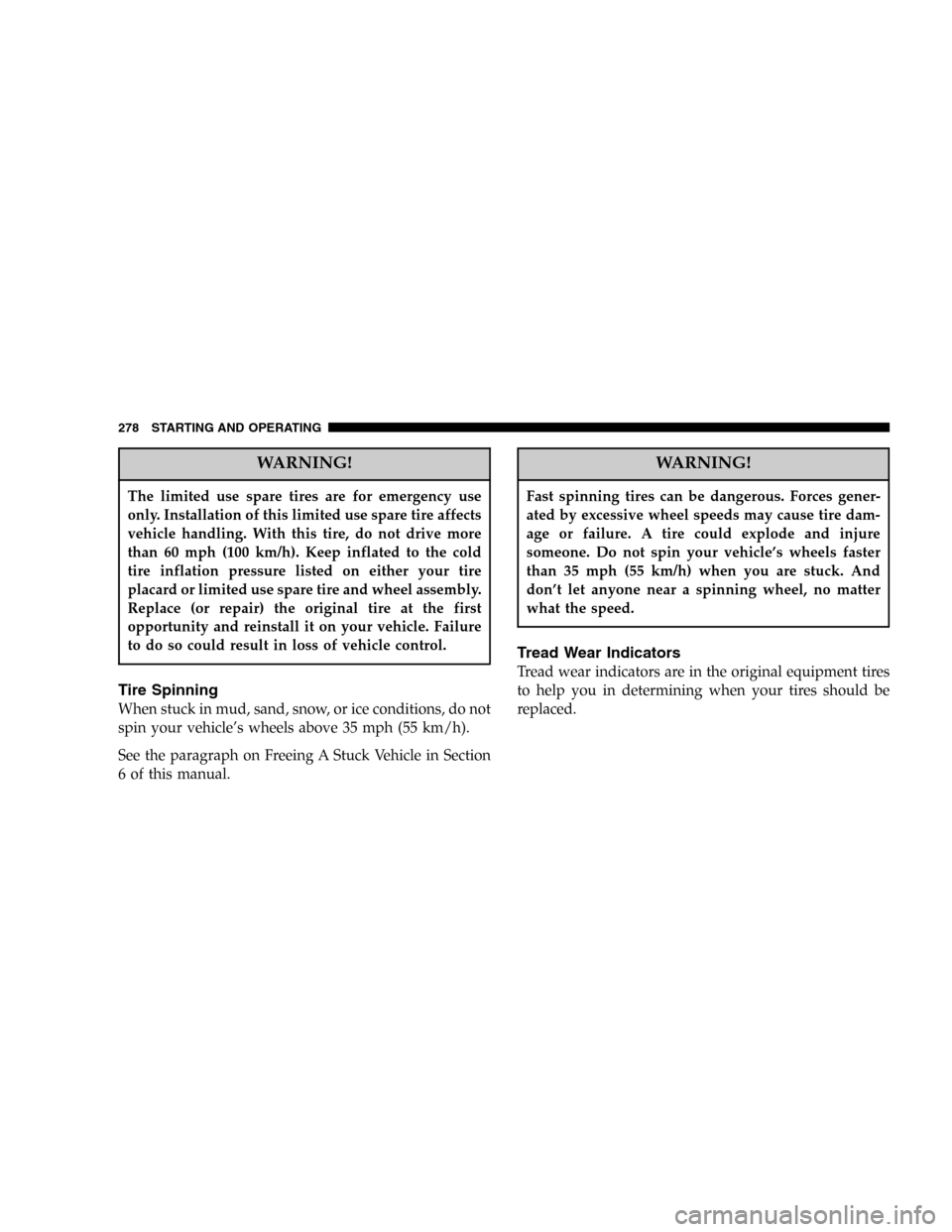Page 278 of 420

WARNING!
The limited use spare tires are for emergency use
only. Installation of this limited use spare tire affects
vehicle handling. With this tire, do not drive more
than 60 mph (100 km/h). Keep inflated to the cold
tire inflation pressure listed on either your tire
placard or limited use spare tire and wheel assembly.
Replace (or repair) the original tire at the first
opportunity and reinstall it on your vehicle. Failure
to do so could result in loss of vehicle control.
Tire Spinning
When stuck in mud, sand, snow, or ice conditions, do not
spin your vehicle’s wheels above 35 mph (55 km/h).
See the paragraph on Freeing A Stuck Vehicle in Section
6 of this manual.
WARNING!
Fast spinning tires can be dangerous. Forces gener-
ated by excessive wheel speeds may cause tire dam-
age or failure. A tire could explode and injure
someone. Do not spin your vehicle’s wheels faster
than 35 mph (55 km/h) when you are stuck. And
don’t let anyone near a spinning wheel, no matter
what the speed.
Tread Wear Indicators
Tread wear indicators are in the original equipment tires
to help you in determining when your tires should be
replaced.
278 STARTING AND OPERATING
Page 281 of 420

Improper alignment will not cause vehicle vibration.
Vibration may be a result of tire and wheel out-of-
balance. Proper balancing will reduce vibration and
avoid tire cupping and spotty wear.
ALL WHEEL DRIVE (AWD)—IF EQUIPPED
CAUTION!
All Wheel Drive (AWD) vehicles must have the same
size and type tires on all wheel positions. Unequal
tire sizes must not be used. Unequal tire size may
cause failure of the power transfer unit and/or the
viscous coupling.
TIRE PRESSURE MONITOR SYSTEM—IF
EQUIPPED
The Tire Pressure Monitor System (TPM) system uses
wireless technology with wheel rim mounted electronic
sensors to monitor tire pressure levels (EXCLUDING
THE SPARE TIRE). Sensors, mounted to each wheel as
part of the valve stem, transmit tire pressure readings to
the Electronic Vehicle Information Center (EVIC) display
in the instrument cluster.
NOTE:It is particularly important, for you to check the
tire pressure in all of your tires regularly and too main-
tain the proper pressure.
When the appropriate conditions exist, the Electronic
Vehicle Information Center (EVIC) displays the following
messages.
STARTING AND OPERATING 281
5
Page 284 of 420
General Information
This device complies with part 15 of the FCC rules and
RSS 210 of Industry Canada. Operation is subject to the
following conditions:
•This device may not cause harmful interference.
•This device must accept any interference received,
including interference that may cause undesired op-
eration.
The tire pressure sensors are covered under one of the
following licenses:
United States.....................KR5S120123
Canada........................2671-S120123
TIRE CHAINS
Use only compact chains, or other traction aids that meet
SAE type“Class S”specifications. Chains must be the
proper size for the vehicle, as recommended by the chain
manufacturer.
NOTE:Do not use tire chains on a compact spare tire.
284 STARTING AND OPERATING
Page 296 of 420

•Do not attempt to tow a trailer while using a compact
spare tire.
•Whenever you pull a trailer, regardless of the trailer
size, stop lights and turn signals on the trailer are
recommended for motoring safety.
•The automatic transmission fluid and filter should be
changed if you REGULARLY tow a trailer for more
than 45 minutes of continuous operation. See Schedule
“B”in section 8 of this manual for transmission fluid
change intervals.
NOTE:
•Check the automatic transmission fluid level before
towing. Fluid discoloration, or a burnt odor, shows the
need for a transmission fluid and filter change.
•For vehicles equipped with Autostick. By using the
Autostick modes, and selecting a specific gear range,
frequent shifting can be avoided. The highest gear
range should be selected that allows for adequate
performance. For example, choose“4”if the desired
speed can be maintained. Choose“3”or“2”if needed
to maintain the desired speed.
•Extended driving at high RPM should be avoided to
prevent excess heat generation. A reduction in vehicle
speed may be required to avoid extended driving at
high RPM. Return to a higher gear range or vehicle
speed when road conditions and RPM level allows.
296 STARTING AND OPERATING
Page 299 of 420
WHAT TO DO IN EMERGENCIES
CONTENTS
�Hazard Warning Flasher..................300
�If Your Engine Overheats.................301
�Jacking And Tire Changing................302
▫Jack Location........................303
▫Spare Tire Stowage....................304
▫Preparations For Jacking................305
▫Jacking Instructions....................306
�Jump-Starting Procedures If Battery Is Low....309
�Driving On Slippery Surfaces..............311
▫Acceleration.........................311▫Traction............................311
�Freeing A Stuck Vehicle..................312
�Towing A Disabled Vehicle................313
▫With Ignition Key.....................313
▫Without The Ignition Key...............314
▫Towing This Vehicle Behind Another Vehicle
(Flat Towing With All Four Wheels On The
Ground)............................314
▫Towing This Vehicle Behind Another Vehicle
With A Tow Dolley....................315
6
Page 304 of 420
Six Passenger Seating
The jack and jack-handle are stowed in the rear storage
bin located in the rear cargo floor. Pull up on the storage
bin cover and liner to access the jack and jack tools.
Spare Tire Stowage
Five Passenger Seating
The spare tire is stowed under the rear of the vehicle by
means of a cable winch mechanism. To remove or stow
the spare, use the jack handle to rotate the“spare tire
drive”nut. The nut is located under the plastic cover at
the center rear of the cargo floor area, just inside the
liftgate opening.
Six Passenger Seating
The spare tire is stowed under the rear of the vehicle by
means of a cable winch mechanism. To remove or stow
the spare, use the jack handle to rotate the“spare tire
drive”nut. The nut is located under the trim cover at the
center of the rear storage bin in the rear cargo floor.
Jack Location
304 WHAT TO DO IN EMERGENCIES
Page 305 of 420
Spare Tire Removal
Fit the jack-handle over the drive nut. Rotate the nut to
the left until the spare is on the ground with enough slack
cable to allow you to pull the tire out from under the
vehicle.
CAUTION!
The winch mechanism is designed for use with the
jack handle only. Use of an air wrench or other
power tools is not recommended and can damage the
winch.
When the spare is clear, tilt the retainer at the end of the
cable and pull it through the center of the wheel.
Preparations For Jacking
Park the vehicle on a firm level surface, avoid ice or
slippery areas,set the parking brakeand place the gear
selector in PARK. Turn OFF the ignition.Lowering Spare Tire
WHAT TO DO IN EMERGENCIES 305
6
Page 306 of 420
WARNING!
Do not attempt to change a tire on the side of the
vehicle close to moving traffic. Pull far enough off
the road to avoid the danger of being hit when
operating the jack or changing the wheel.
•Turn on the Hazard Warning Flasher.
•Block both the front and rear
of the wheel diagonally oppo-
site the jacking position. For
example, if changing the right
front tire, block the left rear
wheel.
•Passengers should not remain in the vehicle when the
vehicle is being jacked.
Jacking Instructions
1. Remove the spare wheel, scissors jack and jack-handle
from stowage.
2. Carefully pry off the wheel center cap if equipped,
using the tip of the jack handle.
3. Loosen (but do not remove) the wheel lug nuts by
turning them to the left one turn while the wheel is still
on the ground.
4. There are two jack engagement locations on each side
of the body—refer to the following illustration.
306 WHAT TO DO IN EMERGENCIES